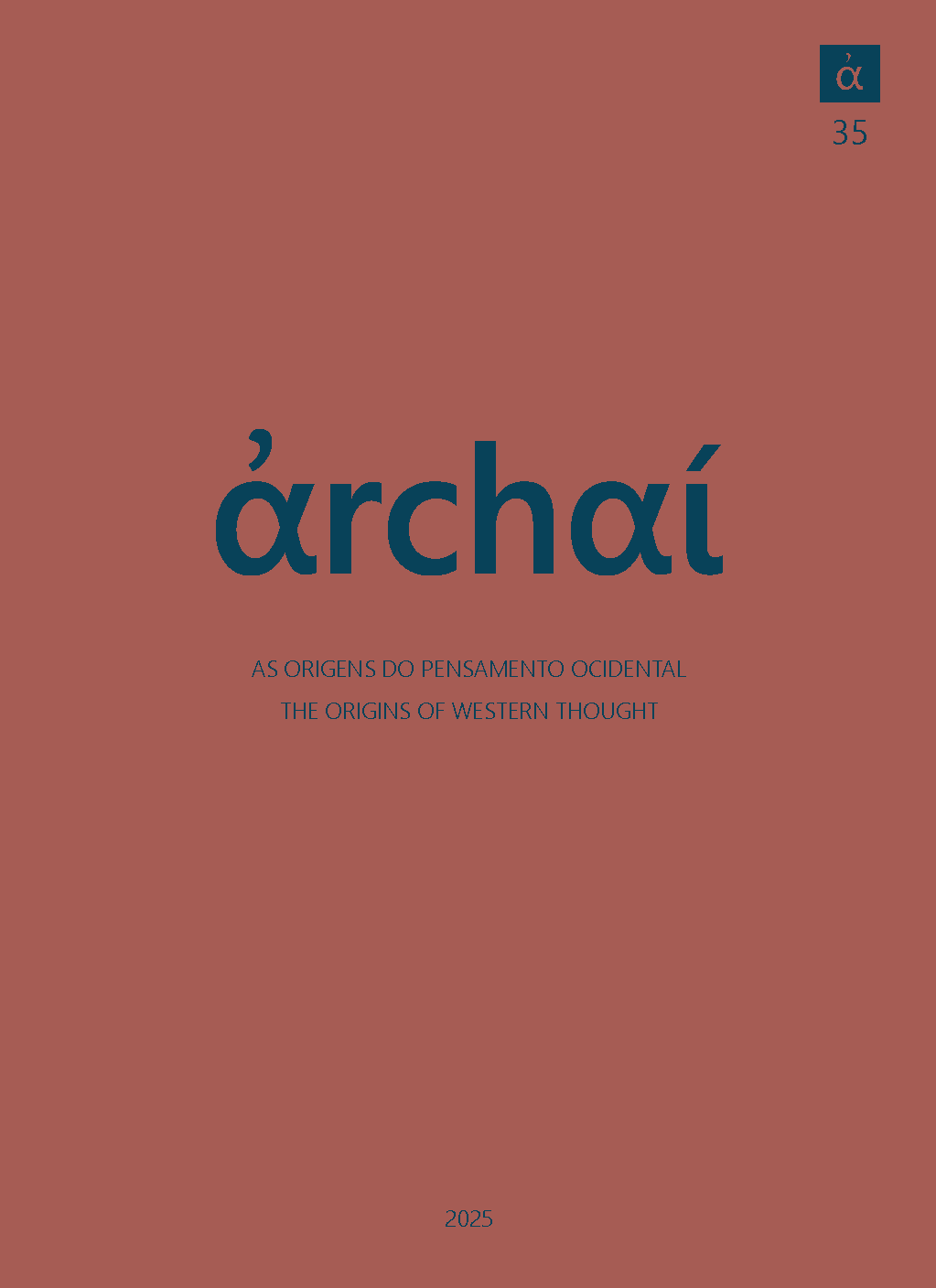Soul as Explanatory Cause of Life in Aristotle: Scientific Knowledge simpliciter (ἁπλῶς) through Coextensive Universal Demonstrations and Context Restriction as a Solution to a Core-Dependent Homonymy from DA II.1-4
DOI:
https://doi.org/10.14195/1984-249X_35_03Keywords:
Aristotle, explanation, homonymy, soulAbstract
The main purpose of this paper is to show, based on Aristotle’s theory of scientific demonstration, how soul plays the role of explanatory cause of life in De Anima (DA) II.1-4. Firstly, I evaluate how, in APo I.2 and II.16, Aristotle requires that universal demonstrations must satisfy a coextensional criterion between a given explanandum (A-term) and its most appropriate explanans (B-term), and that this criterion does not entail a causal symmetry between both those terms. I argue, following Angioni (2014a) and Zuppolini (2018), that, whenever one is before apparent ‘multiple causes’ scenario cases, in which there seems to be more than one possible cause to the same explanandum, one shall still find a unified and fully appropriate explanation of that explanandum. In the second part of this paper, I examine an example from DA II.1-4 in light of APo II.16-17. I argue that soul might be pointed out as the explanatory principle (B) that explains why life (A) belongs to a living body (C). In addition to that, I argue that, although there is a core-dependent homonymy taking place between plants (γ1), animals (γ2) and the nutritive capacity (α1), the nutritive soul (β1) plays the role of an incidental factor (συμβεβηκός) in the context of a scientific demonstration that has by explananda whatsoever attributes (αn) that belong to animals (γ2) qua living beings endowed with a perceptive soul (β1) that explains why attributes (αn) belong to them.Downloads
References
ACKRILL, J. L. (ed.) (1963). Aristotle’s Categories and De interpretatione Oxford, Oxford University Press.
ACKRILL, J. L. (1981). Aristotle’s Theory of Definition: some questions on Posterior Analytics II 8-10. In: BERTI, E. Aristotle on Science: The Posterior Analytics, Proceedings of the Eighth Symposium Aristotelicum Padova, Editrice Antenore, p. 359-384. Also In: ACKRILL, J. Essays on Plato and Aristotle Oxford, Clarendon Press, p. 110- 130.
ANGIONI, L. (2007). O conhecimento científico no livro I dos Segundos Analíticos de Aristóteles. Journal of Ancient Philosophy 1, n. 2, p. 1-24.
ANGIONI, L. (2012). Os seis requisitos das premissas da demonstração científica em Aristóteles (Segundos Analíticos I 2). Manuscrito 35, p. 7-60.
ANGIONI, L. (2014a). Aristotle on Necessary Principles and on Explaining X Through the Essence of X. Studia Philosophica Estonica 7, n. 2, p. 88-112.
ANGIONI, L. (2014b). Demonstração, silogismo e causalidade. In: ANGIONI, L. (ed.). Lógica e Ciência em Aristóteles Campinas, Editora PHI, p. 61-120.
ANGIONI, L. (2016). Aristotle’s Definition of Scientific Knowledge (APo 71b 9-12). Logical Analysis and History of Philosophy 19, p. 79-105.
ANGIONI, L. (2018). Causality and Coextensiveness in Aristotle’s Posterior Analytics 1.13. Oxford Studies in Ancient Philosophy 54, p. 159-185
ANGIONI, L. (2019). What Really Characterizes Explananda: Prior Analytics, I, 30. Eirene. Studia Graeca et Latina 55, p. 147-177.
ANGIONI, L. (2020). Aristóteles e a necessidade do conhecimento científico. Discurso 50, n.2, p. 193-238.
BARNES, J. (ed.) (1993). Posterior Analytics Oxford, Oxford University Press .
BIEHL, G. (ed.) (1884). Aristotelis. De Anima libri III Lipsiae, Teubner.
BOLTON, R. (1976). Essentialism and Semantic Theory in Aristotle: Posterior Analytics, II, 7-10. The Philosophical Review 85, no. 4, p. 514-544.
BRONSTEIN, D. (2016). Aristotle on Knowledge and Learning: The Posterior Analytics Oxford, Oxford University Press .
BURNYEAT, M.F. (1981). Aristotle on Understanding Knowledge. In: BERTI, E.(ed.). Aristotle on Science- The Posterior Analytics Padova, Editrice Antenore , p. 97-140.
CHARLES, D. (2000). Aristotle on Meaning and Essence Oxford, Clarendon Press.
FEREJOHN, M. (2013). Formal Causes: Definition, Explanation, and Primacy in Socratic and Aristotelian Thought Oxford, Oxford University Press .
FINE, G. (2010). Aristotle’s Two Worlds: Knowledge and Belief in Posterior Analytics 1.33. Proceedings of the Aristotelian Society 110, p. 323-46.
HASPER, P. (2006). Sources of Delusion in Analytica Posteriora 1.5. Phronesis 51, p. 252-284.
LENNOX, J. G. (1987). Divide and Explain: The Posterior Analytics in Practice. In: GOTTHELF, A.; Lennox, J. G. (eds.). Philosophical Issues in Aristotle’s Biology Cambridge, Cambridge University Press, p. 90-119.
ROSS, W. D. (ed.) (1949). Aristotle’s Prior Analytics and Posterior Analytics Oxford, Oxford University Press .
SHIELDS, C. (1999). Order in Multiplicity. Homonymy in the Philosophy of Aristotle Oxford, Clarendon Press .
ZUPPOLINI, B. A. (2018). Explanation and Essence in Posterior Analytics II 16-17. Revista Archai 24, p. 229-264.
Downloads
Published
How to Cite
Issue
Section
License
Copyright (c) 2025 Ahmad Suhail Farhat

This work is licensed under a Creative Commons Attribution 4.0 International License.
Given the public access policy of the journal, the use of the published texts is free, with the obligation of recognizing the original authorship and the first publication in this journal. The authors of the published contributions are entirely and exclusively responsible for their contents.
1. The authors authorize the publication of the article in this journal.
2. The authors guarantee that the contribution is original, and take full responsibility for its content in case of impugnation by third parties.
3. The authors guarantee that the contribution is not under evaluation in another journal.
4. The authors keep the copyright and convey to the journal the right of first publication, the work being licensed under a Creative Commons Attribution License-BY.
5. The authors are allowed and stimulated to publicize and distribute their work on-line after the publication in the journal.
6. The authors of the approved works authorize the journal to distribute their content, after publication, for reproduction in content indexes, virtual libraries and similars.
7. The editors reserve the right to make adjustments to the text and to adequate the article to the editorial rules of the journal.














